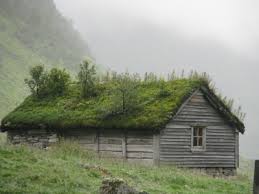 A sod roof is a type of a traditional northern European green roof. You still see them often in the Faroe Islands, west of Norway but also elsewhere in Scandinavia.
A sod roof is a type of a traditional northern European green roof. You still see them often in the Faroe Islands, west of Norway but also elsewhere in Scandinavia.
On a gently sloping, very sturdy wooden roof are laid layers birch bark that are weighted with sods. The birch bark makes the roof waterproof. The sod keeps the birch bark in place.
Birch bark is very suitable as roofing material: it is strong, (light,) water resistant and dirt repellent. It is tough and durable. The normal life expectancy is estimated at 30 years.
To harvest the bark in the longitudinal direction of the stem between two branches made a cut. This is best done in late spring, when the birches thrives. (Depending on the region, to July.) The outer, scaly, white bark is pried loose of the inner (green or rather brown) layer. This phloem (the vascular bundles in the bark that are responsible for the transport of moisture and nutrients) and xylem the tree needs to survive. So you can only remove the outer bark. The scar will remain for many years.
The re-grow of new bark will take 10-20 years. The new (dark) cortex is even of better quality. There may be harvests for several generations. You can also harvest of felled trees.
 The sheets of bark are to be stored flat and under pressure in order to prevent curling. Otherwise, they will deform into a tight roll, turned up in the opposite direction of the natural curve.
The sheets of bark are to be stored flat and under pressure in order to prevent curling. Otherwise, they will deform into a tight roll, turned up in the opposite direction of the natural curve.
The bark is placed up to the top, overlapping like shingles on the roof deck or roof beams. Six layers of birch bark is sufficient, but for a high quality even up to 16 layers were found.
Extra long sheets are used for capping the ridge.
The sods are preferably cut square out off sandy soil in portable pieces of about 30 cm and about 7.5 cm thick. This is half the thickness of the finished coating.
The first layer is traditionally placed with the grass facing down, so the dead grass protects the bark somewhat from humic acid and works as a drainage canal. For the second layer, the vegetation is put top upside. The total thickness of about 15 cm is sufficient to allow survival of the sod in a dry summer .
To keep the turf on spot strong beams are attached along the eaves with natural shaped wooden hooks, preferably sustainable juniper. These are fastened at the underlying roof deck or the supporting roof beams with wooden pegs and covered with extra sheets of birch bark.
The load of about 250 kg per m² of a sod roof has the advantage that it also helps to firmly press the wall together and to seal cracks in a log cabin. In winter the total weight of snow can increase the load to 400 or 500 kg per m²!
Some sod roofs get a mix of flowers sown in the grass, or even a few small trees or shrubs.
Due to their required robust construction the roofs can also be grazed. For goats ladders are positioned as a stepping stone. Even a roof garden is possible.
In modern roof constructions birch bark is replaced by bitumen roofing material used in combination with plastic drainage membranes.
Of birch bark, you can also fold trays and baskets (even for cooking), you can fold and weave it. (And e.g. make shoes.) It's fine kindling for a fire, and you can pull out birch pitch. (The juice you can drink, or make wine of it.)
